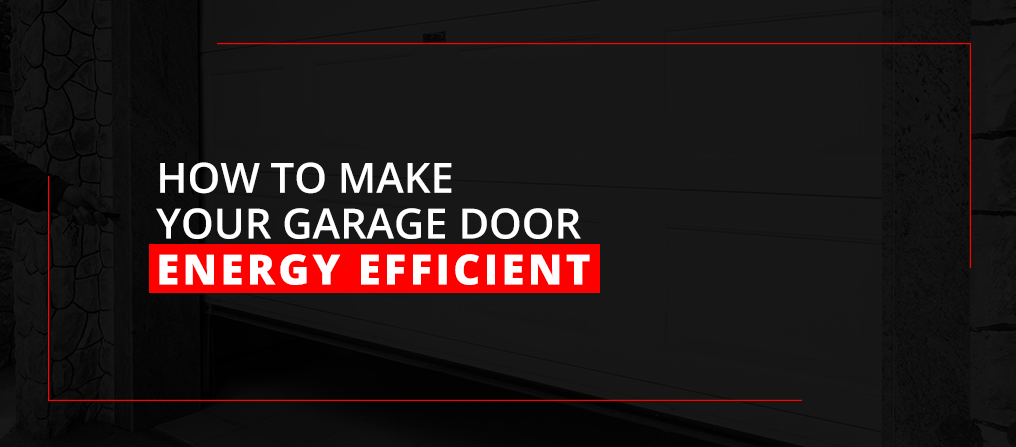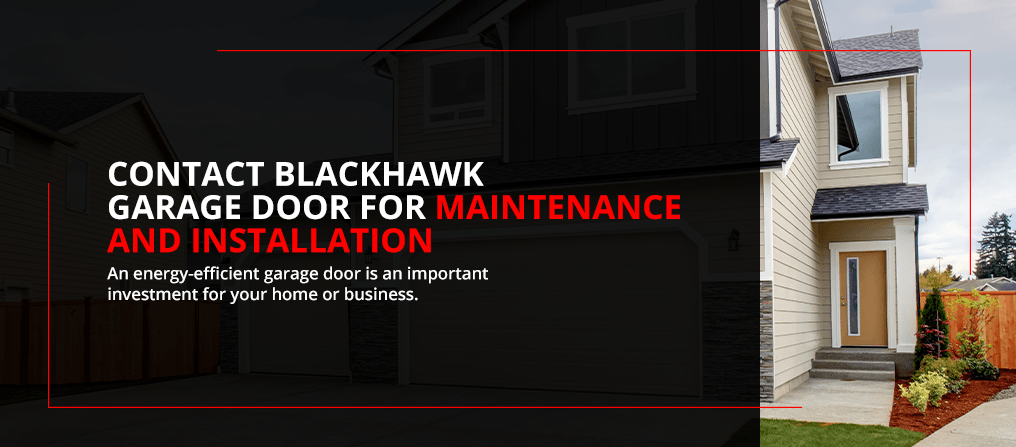[lwptoc depth=”1″ numeration=”none” colorScheme=”inherit”]
Garages are very beneficial for homeowners. They offer a safe storage place and add extra square footage — but your garage can also be wasting money and electricity. One of the largest culprits for garage-related energy waste is an old, damaged or poorly insulated garage door.
Energy-efficient garage doors are an excellent asset because they provide:
- A more comfortable space: If your garage doubles as a workshop, gym, studio or apartment, then a comfortable temperature is essential. Energy-efficient garage doors prevent costly and uncomfortable temperature fluctuations.
- An eco-friendly alternative: About 40% of the United State’s energy consumption goes toward producing electricity. Much of this energy produces greenhouse gases and other pollution. The less power you consume, the more environmentally-friendly your home will be.
- Lower energy costs: Fluctuating garage temperatures are costly to keep up with, especially if your garage is attached. If the temperature is unstable in your garage, it can lower or raise the temperature inside your house.
- Increased resale value: Insulated garage doors, automatic door openers and garage insulation are great ways to boost your home’s resale value because they promise lower utility costs. They also save a potential buyer from having to make upgrades themselves.
Read on to learn more about how to make your garage door efficient.
Insulate the Door
The best way to insulate a garage is to start with the door. An insulated door can help maintain a more comfortable and controlled temperature inside your garage, keeping it up to 12 degrees warmer in the winter and 20 degrees cooler during the summer heat. Garage door insulation can also block out unwanted noise transfer, which is ideal for those who have garage workshops. You can measure an insulated garage door by its R-value. R-value refers to the level of effectiveness for each layer of insulation based on factors like its density, age and type.
When it comes to insulating your garage, you have two choices — use a do-it-yourself insulation kit or consult a professional garage door technician to help. DIY kits come with foam board insulation, reflective insulation or batt insulation to hang along the inside of your door. While this may be an inexpensive solution, a professional garage door technician will get the job done right and take one thing off your to-do list!
Seal Garage Door Cracks
If there are cracks between your garage door and the walls or floor, hot and cold air can easily flow in and out throughout the day. If you rely on an air conditioner or heater to regulate your garage’s temperature, this outside airflow will cause a spike in your energy consumption — and your bill. To seal garage door cracks, apply weatherstripping in areas with large gaps. Weatherstripping is a firm, sometimes flexible strip that fits around your door to prevent lost energy and temperature fluctuation. As you open and close your garage door, weatherstripping on the bottom will not break or scratch because it is made of durable rubber, vinyl or silicone, though some may be made of aluminum or a similar metal.
If your garage door already has weatherstripping, check that it is still attached correctly and in good condition. Signs that indicate possible weatherstripping damage include:
- Excessive drafts around your door.
- Visibly worn or damaged stripping with tears, cracks, dents or corrosion.
- Water puddles, insects or other evidence that the stripping is no longer doing its job.
Contact your garage door servicer for further guidance about how to seal garage door cracks.
Upgrade Your Garage Door Opener
If you have an automatic garage door opener, make sure it’s sized correctly for the job, and there are no visual or audible signs of strain. The harder a garage door opener has to work to move your door, the more energy it consumes in the process. You could also consider upgrading from a standard automatic garage door opener to one with built-in smart technology.
Smart garage door openers tend to use less electricity than a standard automatic door opener because you can program them to turn on and off at specific intervals throughout the day, rather than standing idle. With automatic closing, you also eliminate the possibility of accidentally leaving your door open when you leave your home for the day — an accident that is both a security risk and a significant energy waster.
Replace Your Door With a More Energy-Efficient Garage Door
A damaged or worn garage door is one of the quickest ways to rack up a hefty energy bill. Replace your garage door to reduce garage energy consumption if you have any holes, cracks, rust or excessive dents and scratches. When choosing a new, more efficient garage door, consider the following:
- Material: Each garage door material has different advantages. For example, steel is strong and resistant to most damage. When constructed out of several layers or combined with insulation materials, it’s also great for temperature regulation. Wood, composite wood and doors made of blended materials are also suitable for insulation.
- R-value: Always check the listed R-value for a garage door before making your investment. The higher the R-value, the better it will be for insulation.
- Windows: Garage door windows can be very beneficial, especially if you want to save money by using more natural light. That said, garage door windows can also be a source of energy loss for many homeowners. To combat this, make sure your windows are installed correctly, and there are no gaps or cracks around the windows. You can also consider adding an insulated or low-emissivity glaze to the glass to prevent excess heat transfer.
Schedule Preventative Garage Door Maintenance
Regular garage door maintenace is the best way to address minor concerns before they turn into larger, more energy-wasting issues later. With preventative maintenance from BlackHawk Garage Door, a specialist will visit your home at least once per year to inspect your door’s performance and appearance. They will check each part of your garage door, including the track, nuts, bolts, hardware and springs. The technician will also apply complete lubrication to all moving parts and address any additional concerns you might have.
Additional Tips for an Energy-Efficient Garage
Once you have made your garage door more energy-efficient, you can take some additional steps to create a more energy-efficient garage, including:
- Unplug all unused appliances, such as tools, machinery and exercise equipment.
- Switch to energy-saving lightbulbs and appliances.
- Turn off the light during the day or use natural light when possible.
- Regularly inspect all wiring for energy-wasting damage.
Contact BlackHawk Garage Door for Maintenance and Installation
An energy-efficient garage door is an important investment for your home or business. At BlackHawk Garage Door, we take pride in offering fair and honest service with competitive prices. Visit us online to learn more about our residential and commercial garage door solutions or contact us today to request a free estimate.




